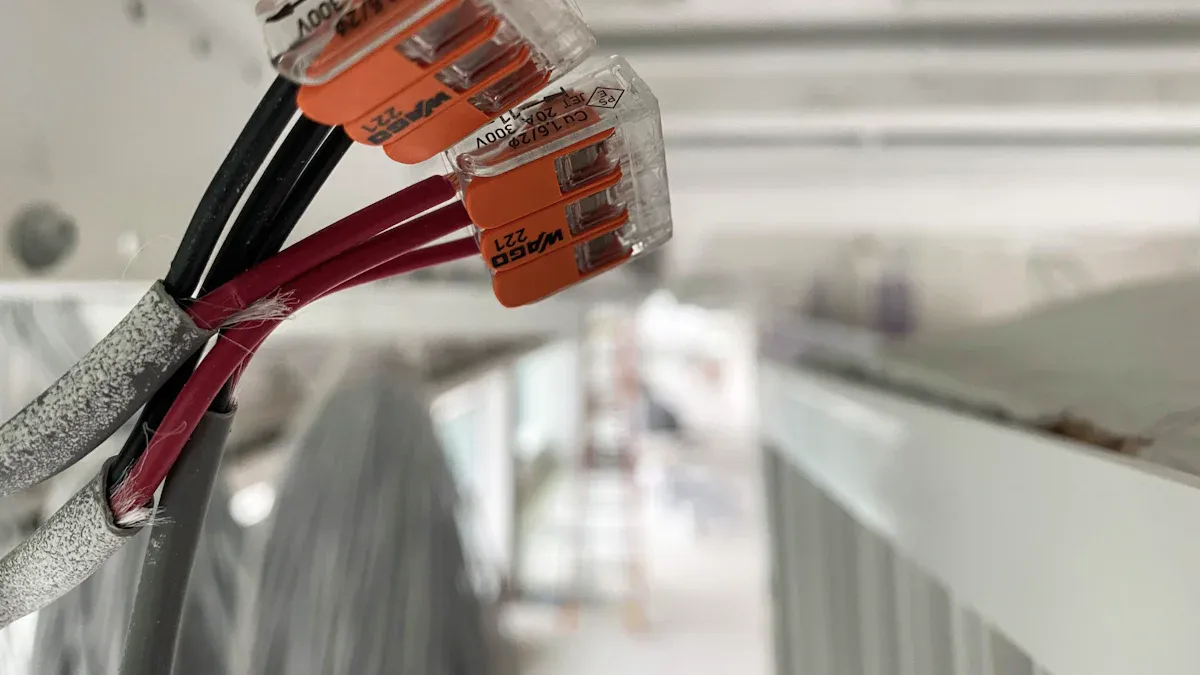

You can choose the right spade connectors by focusing on choosing the right size, type, and material for your project. Start by checking the wire gauge and terminal stud size. Always look at current rating, environment, and safety when choosing the right size. Remember, spade connectors come in many sizes, so choosing the right size helps prevent problems. Use a step-by-step guide for choosing to make sure you succeed. A step-by-step guide for choosing will help with selecting the correct spade connector. Choosing the right size means checking every detail. A step-by-step guide for choosing gives you confidence.
You use spade connectors to join wires to other wires or to devices. These connectors have a flat, fork-shaped end. This shape lets you slide the connector under a screw or bolt. You can remove or replace spade terminals quickly. Many people call them spade terminals because they look like a garden spade. You find these connectors in many types of electrical projects. Each spade connector comes in a specific size. The size must match your wire and the terminal stud. You choose from different types of spade connectors, such as insulated or uninsulated, to fit your needs.
You see spade terminals in many places. They appear in cars, home electronics, and industrial machines. You also find them in audio systems and renewable energy setups. Here are some common applications:
Automotive wiring for lights, speakers, and sensors
Industrial machinery for control panels and motors
Consumer electronics for quick wire changes
Renewable energy systems for solar panel connections
Spade connectors help you make reliable and safe connections. Their design lets you install and remove wires easily. This feature is important for maintenance and upgrades. Industry reports show that spade connectors are popular because they save time and reduce errors. The market for spade terminals grows as more people use electric vehicles and smart devices.
You must pick the right size and type of spade terminals for your project. If you choose the wrong size, your connection may become loose or unsafe. The size of the spade connector must fit both the wire and the terminal stud. Using the correct size helps prevent overheating and electrical failure. You also need to select the right type of spade connectors. Some types of spade connectors work better in wet or high-vibration environments. Others suit indoor use. Always check the size and type before you start your project. This step keeps your electrical connector safe and reliable.
You need to start every electrical project by checking the current and voltage. Each spade connector has a current rating, usually from 1 amp to 50 amps. Voltage ratings often include 50 V, 125 V, 250 V, and 600 V. These numbers matter because they show how much power the connector can handle without failing. If you use a connector with a lower rating than your wiring needs, you risk overheating and damage.
Tip: Always choose spade connectors that can handle the highest current your project might reach, even during short surges.
When selecting spade terminals, follow these steps:
Check the maximum current your wiring will carry, including any possible surges.
Look at the voltage your system uses and make sure the connector’s insulation matches or exceeds this value.
Use connectors designed for high current if your project needs extra reliability and safety.
Selecting spade terminals with the right ratings keeps your electrical connections safe and strong. This step is important for all applications, from automotive repairs to household upgrades and industrial machines.
The environment where you use your spade connectors affects your choice. Heat, moisture, and vibration can change how well your wiring works. For example, automotive projects often face high temperatures and lots of movement. You need connectors that resist heat and stay tight even when the car shakes. In household projects, you might deal with moisture in kitchens or bathrooms. Industrial settings can have dust, oil, or chemicals that damage connectors.
When selecting spade terminals, think about these factors:
Temperature: High heat can weaken some materials.
Moisture: Water can cause rust or short circuits.
Vibration: Movement can loosen electrical connections.
Note: Use insulated spade connectors in wet or dirty places. They protect your wiring and help prevent accidents.
Speaker wire connectors in home audio systems usually stay dry and cool, but you still need to check for dust or pets that might chew on wires. In industrial projects, always look for connectors with extra protection against harsh conditions.
You must match your spade connector to the type of project. Automotive wiring needs connectors that handle heat, vibration, and sometimes oil. Speaker wire connectors in professional audio systems need a large surface area for a strong, clear signal. Home audio projects use speaker wire connectors for easy upgrades and repairs. Household wiring often uses spade connectors for appliances and lighting.
Here are some common applications for spade connectors:
Automotive: Used for lights, sensors, and audio systems. These connectors must survive tough conditions.
Professional audio: Speaker wire connectors provide secure, permanent connections for the best sound.
Household: Used in appliances, lighting, and small repairs. You want connectors that are easy to install and safe.
Industrial: Used in control panels and heavy machines. These connectors must handle high currents and rough environments.
Selecting spade terminals for each application helps you avoid problems. Automotive and industrial projects need tough, reliable connectors. Home and audio projects need connectors that are easy to use and give a clean signal. Always check your project type before choosing your wiring and connectors.
